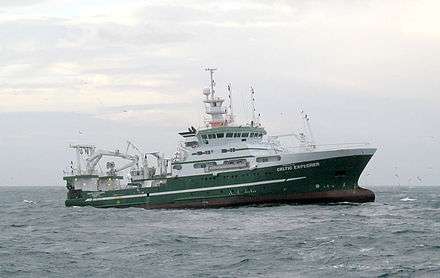Photobioreactor
A photobioreactor (PBR) is a bioreactor that utilizes a light source to cultivate phototrophic microorganisms.[1] These organisms use photosynthesis to generate biomass from light and carbon dioxide and include plants, mosses, macroalgae, microalgae, cyanobacteria and purple bacteria. Within the artificial environment of a photobioreactor, specific conditions are carefully controlled for respective species. Thus, a photobioreactor allows much higher growth rates and purity levels than anywhere in nature or habitats similar to nature. Hypothetically, phototropic biomass could be derived from nutrient-rich wastewater and flue gas carbon dioxide in a photobioreactor.
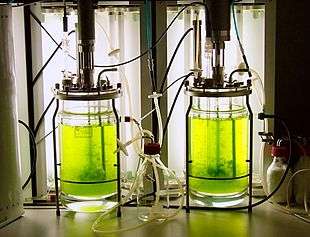
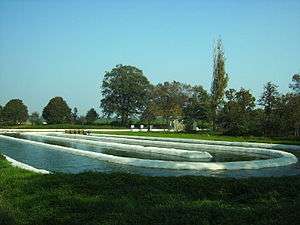
Open systems
The first approach for the controlled production of phototrophic organisms was a natural open pond or artificial raceway pond. Therein, the culture suspension, which contains all necessary nutrients and carbon dioxide, is pumped around in a cycle, being directly illuminated from sunlight via the liquid’s surface. This construction principle is the simplest way of production for phototrophic organisms. But due to their depth (up to 0.3 m) and the related reduced average light supply, open systems only reach limited areal productivity rates. In addition, the consumption of energy is relatively high, as high amounts of water containing low product concentration have to be processed. Open space is expensive in areas with a dense population, while water is rare in others. Using open technologies causes high losses of water due to evaporation into the atmosphere.
Closed systems
Since the 1950s several approaches have been conducted to develop closed systems, which theoretically provide higher cell densities of phototrophic organisms and therefore a lower demand of water to be pumped than open systems. In addition, closed construction avoids system-related water losses and the risk of contamination through landing water birds or dust is minimized.[2] All modern photobioreactors have tried to balance between a thin layer of culture suspension, optimized light application, low pumping energy consumption, capital expenditure and microbial purity. Many different systems have been tested, but only a few approaches were able to perform at an industrial scale.[3]
Redesigned laboratory fermenters
The simplest approach is the redesign of the well-known glass fermenters, which are state of the art in many biotechnological research and production facilities worldwide. The moss reactor for example shows a standard glass vessel, which is externally supplied with light. The existing head nozzles are used for sensor installation and for gas exchange.[4] This type is quite common in laboratory scale, but it has never been established in bigger scale, due to its limited vessel size.
Tubular photobioreactors
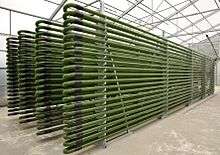
Made from glass or plastic tubes, this photobioreactor type has succeeded within production scale. The tubes are oriented horizontally or vertically and are supplied from a central utilities installation with pump, sensors, nutrients and CO2. Tubular photobioreactors are established worldwide from laboratory up to production scale, e.g. for the production of the carotenoid Astaxanthine from the green algae Haematococcus pluvialis or for the production of food supplement from the green algae Chlorella vulgaris. These photobioreactors take advantage from the high purity levels and their efficient outputs. The biomass production can be done at a high quality level and the high biomass concentration at the end of the production allows energy efficient downstream processing.[5] Due to the recent prices of the photobioreactors, economically feasible concepts today can only be found within high-value markets, e.g. food supplement or cosmetics.[6]
The advantages of tubular photobioreactors at production scale are also transferred to laboratory scale. A combination of the mentioned glass vessel with a thin tube coil allows relevant biomass production rates at laboratory research scale. Being controlled by a complex process control system the regulation of the environmental conditions reaches a high level.[7]
Christmas tree photobioreactor
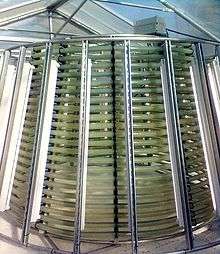
An alternative approach is shown by a photobioreactor, which is built in a tapered geometry and which carries a helically attached, translucent double hose circuit system.[8] The result is a layout similar to a Christmas tree. The tubular system is constructed in modules and can theoretically be scaled outdoors up to agricultural scale. A dedicated location is not crucial, similar to other closed systems, and therefore non-arable land is suitable as well. The material choice should prevent biofouling and ensure high final biomass concentrations. The combination of turbulence and the closed concept should allow a clean operation and a high operational availability.[9]
Plate photobioreactor
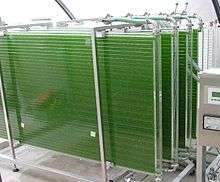
Another development approach can be seen with the construction based on plastic or glass plates. Plates with different technical design are mounted to form a small layer of culture suspension, which provides an optimized light supply. In addition, the simpler construction compared to tubular reactors allows the use of less expensive plastic materials. From the pool of different concepts e.g. meandering flow designs or bottom gassed systems have been realized and shown good output results. Some unsolved issues are material life time stability or the biofilm forming. Applications at industrial scale are limited by the scalability of plate systems.[10]
In April 2013, the IBA in Hamburg, Germany, a building with an integrated glass plate photobioreactor facade, was commissioned.[11]
Horizontal photobioreactor
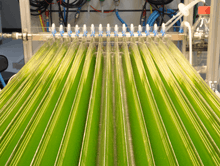
This photobioreactor type consists of a plate-shaped basic geometry with peaks and valleys arranged in regular distance. This geometry causes the distribution of incident light over a larger surface which corresponds to a dilution effect. This also helps solving a basic problem in phototrophic cultivation, because most microalgae species react sensitively to high light intensities. Most microalgae experience light saturation already at light intensities, ranging substantially below the maximum daylight intensity of approximately 2000 W/m2. Simultaneously, a larger light quantity can be exploited in order to improve photoconversion efficiency. The mixing is accomplished by a rotary pump, which causes a cylindrical rotation of the culture broth. In contrast to vertical designs, horizontal reactors contain only thin layers of media with a correspondingly low hydrodynamic pressure. This has a positive impact on the necessary energy input and reduces material costs at the same time.
Foil photobioreactor
The pressure of market prices has led the development of foil-based photobioreactor types. Inexpensive PVC or PE foils are mounted to form bags or vessels which cover algae suspensions and expose them to light. The pricing ranges of photobioreactor types have been enlarged with the foil systems. It has to be kept in mind, that these systems have a limited sustainability as the foils have to be replaced from time to time. For full balances, the investment for required support systems has to be calculated as well.[12]
Porous Substrate Bioreactor
Porous Substrate Bioreactor (PSBR), being developed at University of Cologne, also known as the twin-layer system, uses a new principle to separate the algae from a nutrient solution by means of a porous reactor surface on which the microalgae are trapped in biofilms. This new procedure reduces by a factor of up to one hundred the amount of liquid needed for operation compared to the current technology, which cultivates algae in suspensions. As such, the PSBR procedure significantly reduces the energy needed while increasing the portfolio of algae that can be cultivated.
Outlook
The discussion around microalgae and their potentials in carbon dioxide sequestration and biofuel production has caused high pressure on developers and manufacturers of photobioreactors.[13] Today, none of the mentioned systems is able to produce phototrophic microalgae biomass at a price which is able to compete with crude oil. New approaches test e.g. dripping methods to produce ultra-thin layers for maximal growth with application of flue gas and waste water. Further on, much research is done worldwide on genetically modified and optimized microalgae.
See also
References
- "Photobioreactor - Definition, Glossary, Details - Oilgae". Glossary. Oilgae. Retrieved 2015-03-10.
- Lane. G. (2013). Up To Speed On: Algae Biofuels. 1. Smashwords. pp. 1–9. ISBN 9781301351961.
- Submariner Project: Photobioreactor design principles
- Decker, Eva; Ralf Reski (2008). "Current achievements in the production of complex biopharmaceuticals with moss bioreactors". Bioprocess and Biosystems Engineering. 31 (1): 3–9. doi:10.1007/s00449-007-0151-y. PMID 17701058.
- Oliva, Giuseppina; Ángeles, Roxana; Rodríguez, Elisa; Turiel, Sara; Naddeo, Vincenzo; Zarra, Tiziano; Belgiorno, Vincenzo; Muñoz, Raúl; Lebrero, Raquel (December 2019). "Comparative evaluation of a biotrickling filter and a tubular photobioreactor for the continuous abatement of toluene". Journal of Hazardous Materials. 380: 120860. doi:10.1016/j.jhazmat.2019.120860. PMID 31302359.
- Pulz. O. (2001). "Photobioreactors: production systems for phototrophic microorganisms". Applied Microbiology and Biotechnology. 57 (3): 287–293. doi:10.1007/s002530100702. PMID 11759675.
- Algae Observer: IGV Biotech Presents Novel Algae Screening System
- F. Cotta, M. Matschke, J. Großmann, C. Griehl und S. Matthes; "Verfahrenstechnische Aspekte eines flexiblen, tubulären Systems zur Algenproduktion" (Process-related aspects of a flexible, tubular system for algae production); DECHEMA 2011
- Großmann Ingenieur Consult GmbH: Aufbau eines Biosolarzentrums in Köthen, 6. März 2011.
- Handbook of microalgal culture. 1 (2nd ed.). Blackwell Science Ltd. 2013. ISBN 978-0-470-67389-8.
- Briegleb, Till (2013-03-25). "IBA Hamburg - Opening, Algaehouse, Worldquartier". Art Magazin. Archived from the original on 2013-03-28.
- Zittelli, Graziella; Liliana Rodolfi; Niccolo Bassi; Natascia Biondi; Mario R. Tredici (2012). "Chapter 7 Photobioreactors for Microalgae Biofuel Production". In Michael A. Borowitzka, Navid R. Moheimani (ed.). Algae for Biofuels and Energy. Springer Science & Business Media. pp. 120–121. ISBN 9789400754799.
- Spolaore. P.; et al. (2006). "Commercial Applications of Microalgae" (PDF). Journal of Bioscience and Bioengineering. 102 (2): 87–96. doi:10.1263/jbb.101.87. PMID 16569602.
